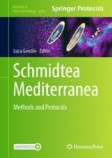Search
Search Results
-
Investigation of the Physiological Role of Serotonin in the Muscle Function in Planaria
Abstract —In the present study, close spatial relationships between peripheral serotoninergic nerve elements and the musculature of the body in...

-
The Ancient Origin and Function of Germline Cysts
Gamete production in most animal species is initiated within an evolutionarily ancient multicellular germline structure, the germline cyst, whose...
-
Picroscope: low-cost system for simultaneous longitudinal biological imaging
Simultaneous longitudinal imaging across multiple conditions and replicates has been crucial for scientific studies aiming to understand biological...

-
Formalizing Phenotypes of Regeneration
Regeneration experiments can produce complex phenotypes including morphological outcomes and gene expression patterns that are crucial for the...
-
Early Insights: A Fascination with Metabolic Gradients
Life consists of energy conversion, information, and replication. Evolutionary biology tends to focus less on energy and more on...
-
Potential of Utilizing Allochthonous Invertebrates by Gammarus koreanus Uéno (Amphipoda)
AbstractIn an isolating experiment on feeding only on arthropods of terrestrial origin, the potential of their consumption by amphipods from a...

-
Darwin’s agential materials: evolutionary implications of multiscale competency in developmental biology
A critical aspect of evolution is the layer of developmental physiology that operates between the genotype and the anatomical phenotype. While much...

-
A Planarian Model System to Study Host-Pathogen Interactions
This protocol is focused on using the recently established planarian infection model system to study host-pathogen interactions during fungal...
-
Bioelectric networks: the cognitive glue enabling evolutionary scaling from physiology to mind
Each of us made the remarkable journey from mere matter to mind: starting life as a quiescent oocyte (“just chemistry and physics”), and slowly,...

-

-
Live Imaging of Planaria
Planarian regeneration involves a complex series of cellular events, precisely choreographed in space and time. Time-lapse imaging can provide...
-
Are Planaria Individuals? What Regenerative Biology is Telling Us About the Nature of Multicellularity
Freshwater planaria (Platyhelminthes, Turbellaria, Tricladida) pose a challenge to current concepts of biological individuality. We review molecular...

-
TUNEL Staining in Sections of Paraffin-Enabled Planarians
Planarians are a model animal for the study of regeneration and homeostasis. Understanding how planarians control their cellular balance is key to...
-
Flatworms: Platyhelminthes
Although the majority of the species in the phylum of flatworms is parasitic, the subphylum Turbellaria contains free-living animals (Ball and...
-
The Species Composition and Occurrence of Free-Living Flatworms (Plathelminthes) in the Freshwater Fauna of the Middle Volga Region
AbstractAccording to our own and literature generalized data, 84 species from 34 genera of free-living flatworms (Plathelminthes: Catenulida,...

-
Pretraining a foundation model for generalizable fluorescence microscopy-based image restoration
Fluorescence microscopy-based image restoration has received widespread attention in the life sciences and has led to significant progress,...

-
Collective intelligence: A unifying concept for integrating biology across scales and substrates
A defining feature of biology is the use of a multiscale architecture, ranging from molecular networks to cells, tissues, organs, whole bodies, and...

-
Host preference of a symbiotic flatworm and its response to conspecific and host mucus
Mucus-mediated communication plays a significant role in sha** community dynamics, particularly in marine organisms found in intertidal zones with...

-
Free-Living Flatworms (Turbellaria)
AbstractThe results of studies on the fauna, ecology, and biological resources of free-living flatworms are presented. The data on the qualitative...

